Why you can trust Tom's Hardware
The ROG Swift PG259QN’s Racing mode yields a reasonably accurate image that has a little room for improvement. All calibration controls are available, so optimal performance is easy to achieve (see our recommended calibration settings on page 1).
Grayscale and Gamma Tracking
We describe our grayscale and gamma tests in detail here.
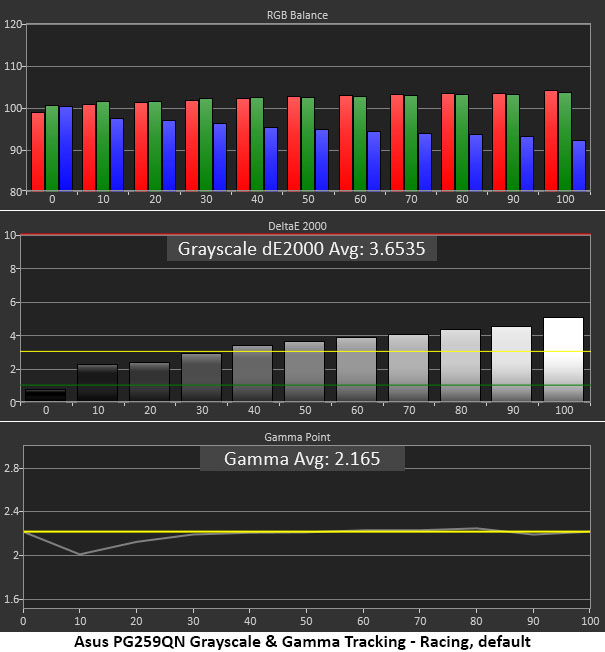

Our initial measurement run showed a slightly warm tint to the grayscale step pattern. Though the errors are visible in steps above 40% brightness, it didn’t have a huge effect on the picture, but the image didn’t pop quite as much as it could.
Gamma was near-perfect with only a small dip at 10%, indicating a rise in luminance at that brightness level.
Our calibration produced a professional-grade grayscale with all errors below a Delta E (dE) of 1. This improved perceived contrast and brought out highlights more for a three-dimensional look and better color saturation. Gamma was unchanged.
Comparisons

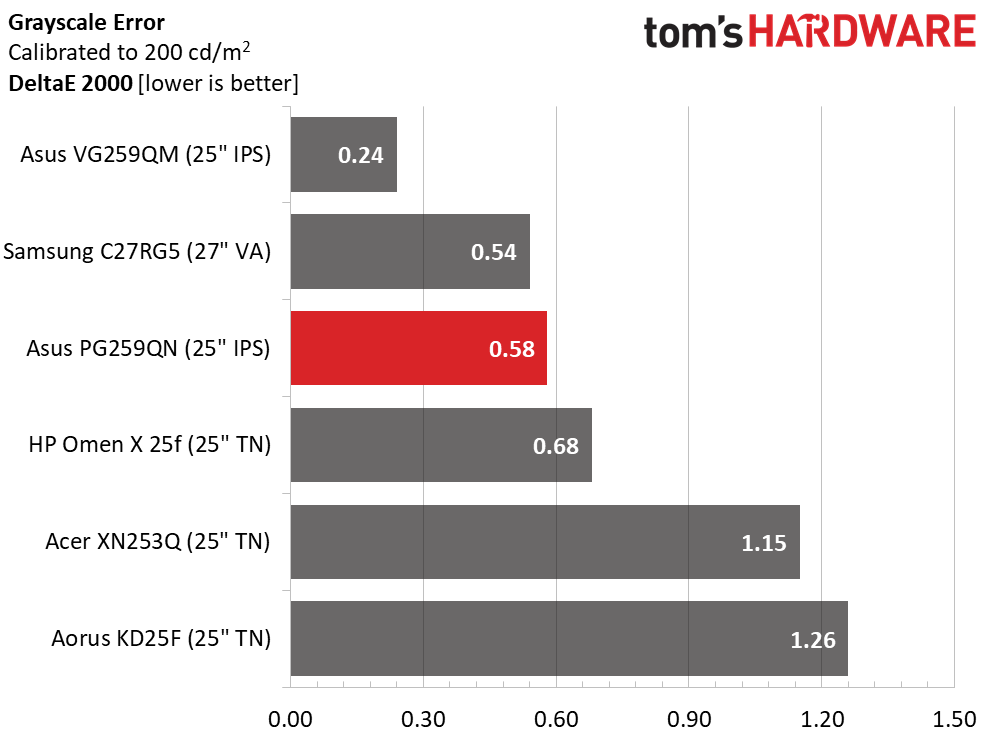
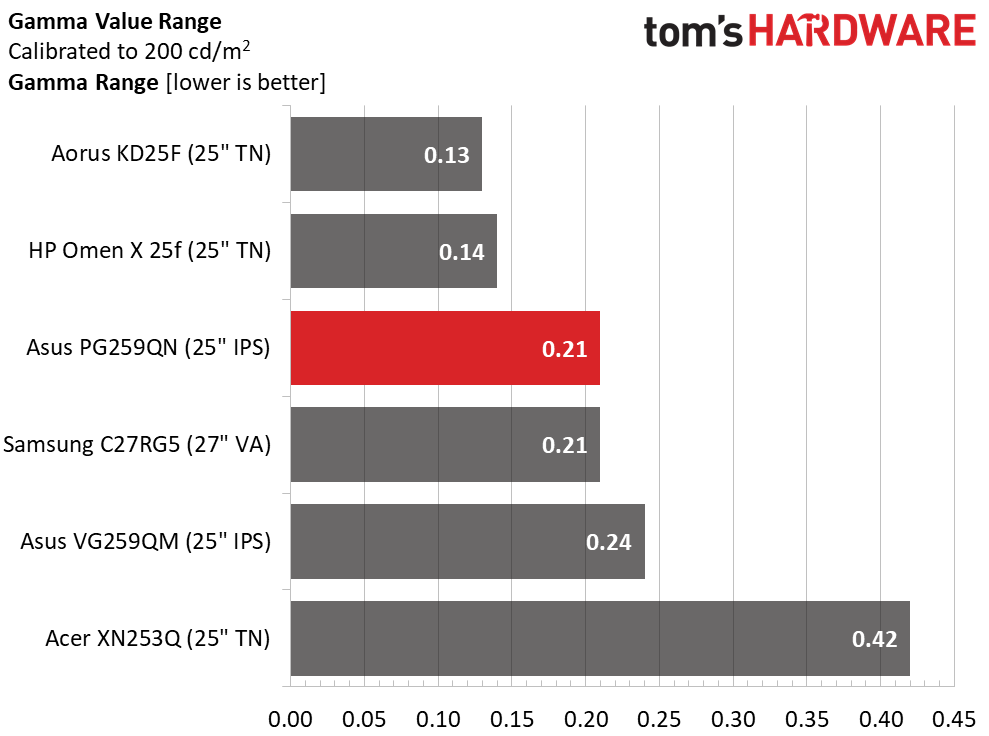

A 3.65dE average grayscale means you don’t really need to calibrate the PG259QN, but probably should. Just a few tweaks are needed to reduce the error to a tiny 0.58dE. Only the PG259QN’s stablemate, the VG259QM, and the Samsung can boast better. The naked eye will see no difference among the three.
Gamma tracks tightly at a small 0.21 range of values. Average error is 2.15 for a 2.27% deviation from 2.2. Since the error is only at 10%, you won’t see a problem in real-world content.
Color Gamut Accuracy
For details on our color gamut testing and volume calculations, click here.
Get Tom's Hardware's best news and in-depth reviews, straight to your inbox.


The PG259QN is an sRGB monitor with no option for extended color. It covers that spec very accurately, with a nearly spot-on initial measurement. The warm white point pulls red and cyan a little off their hue targets and blue is slightly over-saturated at the 100% mark.
Our calibration fixed those errors neatly, taking the PG259QN to a high level of color accuracy. By the numbers, magenta is a little off in hue, and the 80% red point is about 5% under-saturated. But to the naked eye, the monitor looked very good post-calibration.
Comparisons
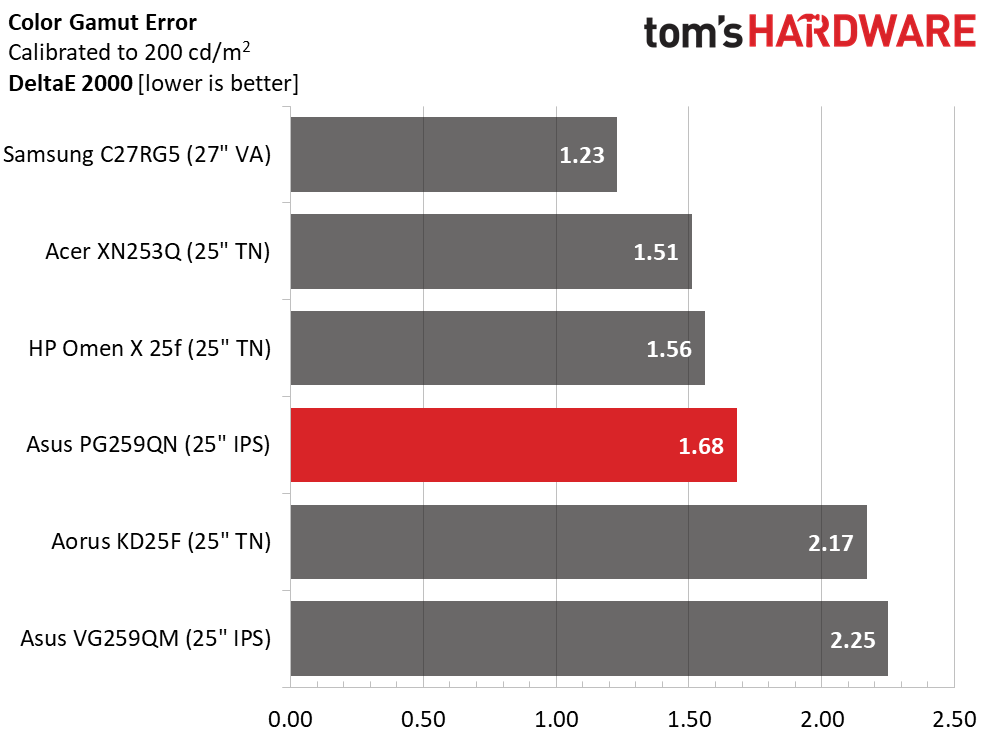
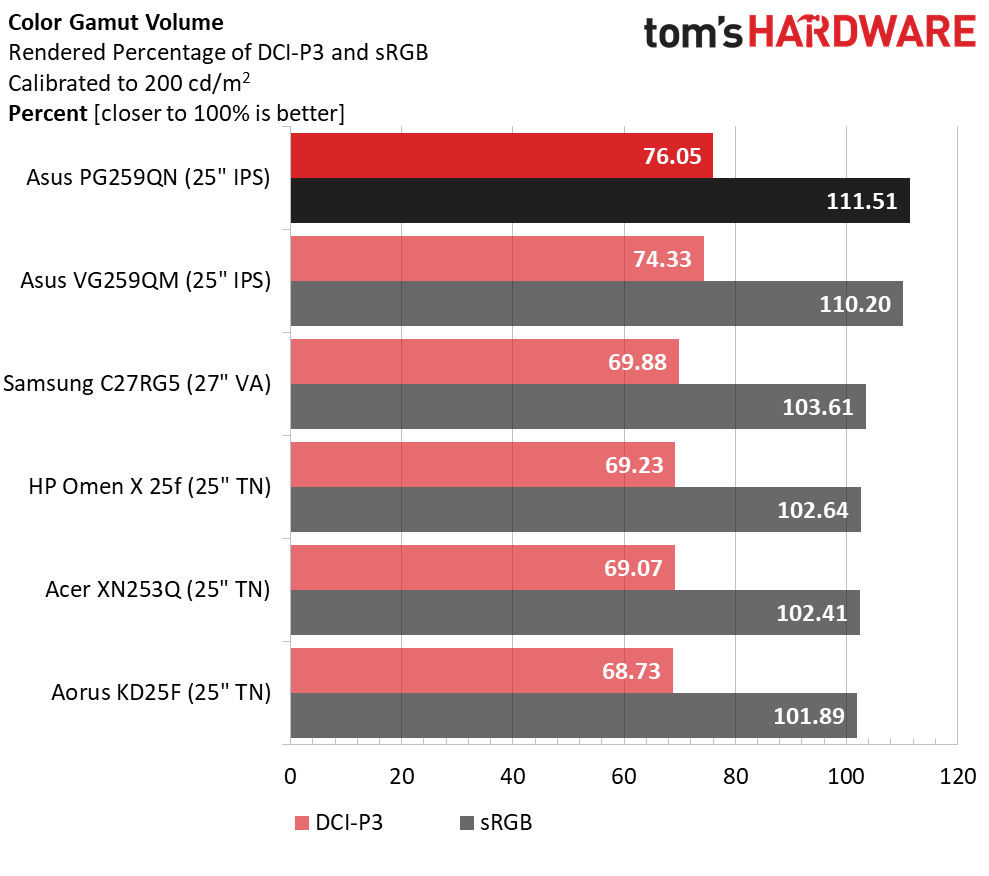
All of the monitors in our sample group calibrate to a high color accuracy standard. The PG259QN ended up mid-pack with an excellent 1.68dE result. There is nothing to complain about here.
None of our super-speedy screens feature a wide color gamut. But the PG259QN covers more of the sRGB and DCI-P3 color spaces than the others. It is very colorful in practice, but a DCI-P3-native monitor would render greater color saturation. If sRGB accuracy is a priority for you, this screen provides excellent performance. If you need critical accuracy, we recommend a software profile.
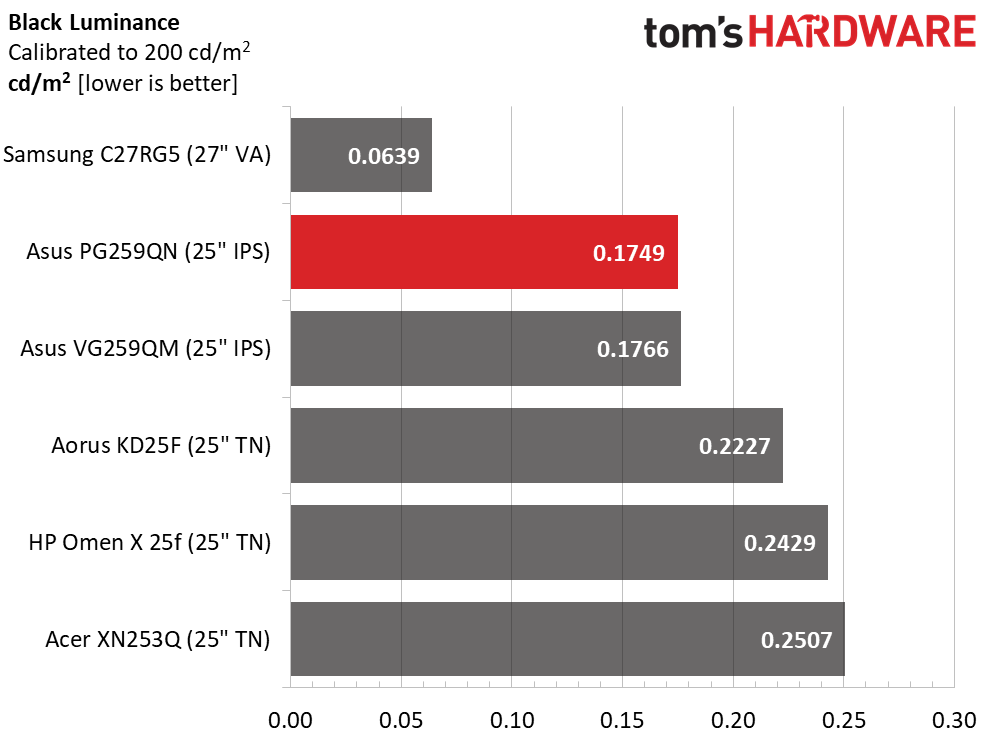

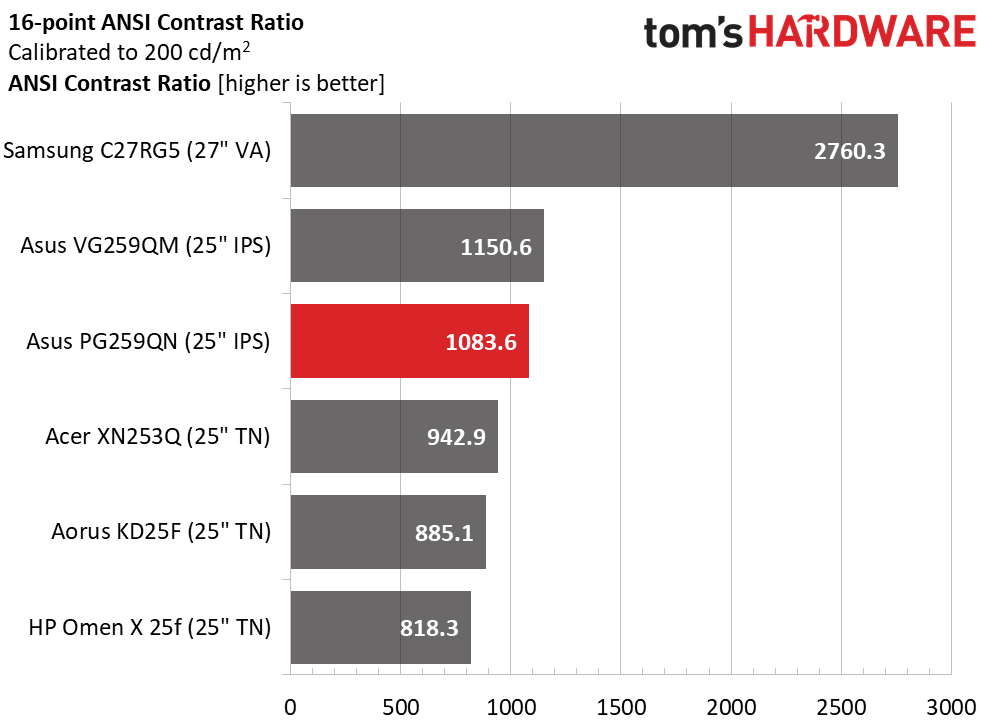
Current page: Grayscale, Gamma and Color
Prev Page Brightness and Contrast Next Page HDR Performance
Christian Eberle is a Contributing Editor for Tom's Hardware US. He's a veteran reviewer of A/V equipment, specializing in monitors. Christian began his obsession with tech when he built his first PC in 1991, a 286 running DOS 3.0 at a blazing 12MHz. In 2006, he undertook training from the Imaging Science Foundation in video calibration and testing and thus started a passion for precise imaging that persists to this day. He is also a professional musician with a degree from the New England Conservatory as a classical bassoonist which he used to good effect as a performer with the West Point Army Band from 1987 to 2013. He enjoys watching movies and listening to high-end audio in his custom-built home theater and can be seen riding trails near his home on a race-ready ICE VTX recumbent trike. Christian enjoys the endless summer in Florida where he lives with his wife and Chihuahua and plays with orchestras around the state.
-
Dayne_87 That's great, but I prefer resolution over frame rate. I have a 1440p Asus ROG 27" with 144hz and G-sync and I'm fine with that for now. If I were going to upgrade for that price I would want it to be at least 1440p 360hz or 4k 144hz or faster and still 27".Reply -
thepersonwithaface45 No idea why companies are focusing on high refresh rates at 1080p. This is the 4k generation, 2k was last gen and we should be getting more choices in the 4k range. Which I'm sure we will, but I don't see anyone paying $700 for a 1080p high refresh rate monitor when for $100 more you can get a 144hz 4k 27" monitor.Reply
Infact, this one is only 24.5"?
What? What is that price for that resolution, you're really just paying for 360hz? -
Jonagold What are all the included latencies in your Absolute Input Lag testing? Could there potentially be mouse button latency included? Also system latency? What are frame-times etc.?Reply -
ashburner This is for competitive gamers and that's it. They are notorious for running high framerate at low resolution. Even at 1080p, almost all effect settings are turned off. It's kinda crap to watch but it works for them. I prefer 2K at 27". I'm at 165hz now but I'm looking at a 4K 27". My 3080 should be in on Tuesday.Reply -
nofanneeded I dont know whats stopping Tomshardware from reviewing LG Oled 4K 55 inch TV for gaming ? it has everything one needs for gaming even Nvidia Gsync.Reply -
mdrejhon Founder of Blur Busters / Inventor of TestUFO here.Reply
I should compliment Toms Hardware for improved mainstream-writing description of how motion blur is reduced -- doubling Hz halves display motion blur, as an alternative to strobing. Yesterday's media used to dismiss high Hz, or was not familiar with the benefits of high Hz.
I would, recommend that TomsHardware do pursuit camera tests with instructions at the forums:
https://forums.blurbusters.com/viewforum.php?f=23(Even an iPhone works as a pursuit camera!) -
mdrejhon Reply
Not necessarily. If you own a 120Hz iPad, you'll notice web browser scrolling is 2x clearer. LCD motion blur halves when LCD Hz doubles. And my 360 Hz monitor has 1/6th web browser scrolling motion blur of a 60 Hz LCD monitor.ashburner said:This is for competitive gamers and that's it.
I have the PG259QN here too, and it's absolutely lovely, especially when combined with the Razer 8000 Hz mouse (I have a prototype here).
4K was a $10,000 frivolity in 2001. Today, 4K is a $299 Walmart special. The mainstreaming of 120 Hz is slowly beginning this decade, with future iPhone/Android devices standardizing at least 120 Hz. But eventually, 240 Hz will be a freebie feature much like Retina screens.
We've almost retina'd out resolution, but we are far away from retina refresh rates. There is already a laboratory engineering path to an 8K 1000Hz display, though that will take many years of progress to reach.
High-Hz isn't just for esports anymore. Though the highest Hz is still expensive and mainly of interest to bigger-budget users. -
CaesarNaykid Reply
I was going to post about your site. My eyes hurt and I cringe every time i see sideways pans in films and I check your site from time to time to see how the race to 1000hz is going. I get why these people like higher resolutions, but even back in the day of the 3DFX Voodoo1 and Voodoo2 SLI I preferred higher framerate over the resolution bumps. I want to see that 1000 hz target hit and this is a positive step that moves the bar even if just a bit towards the goal we need in display technology.mdrejhon said:Founder of Blur Busters / Inventor of TestUFO here.
I should compliment Toms Hardware for improved mainstream-writing description of how motion blur is reduced -- doubling Hz halves display motion blur, as an alternative to strobing. Yesterday's media used to dismiss high Hz, or was not familiar with the benefits of high Hz.
I would, recommend that TomsHardware do pursuit camera tests with instructions at the forums:
https://forums.blurbusters.com/viewforum.php?f=23(Even an iPhone works as a pursuit camera!)